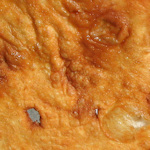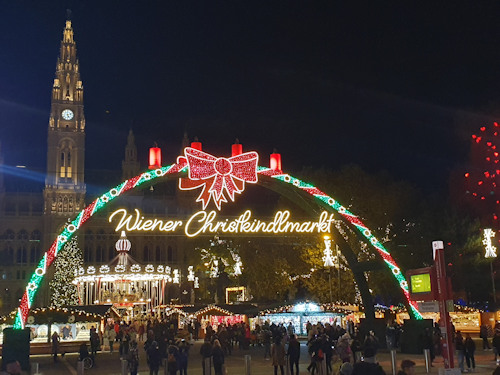
Wander around a Christmas market and you may encounter an alarmingly-large snack that enjoys favoured status among locals. The Langos (pronounced Lan-Gosh) may only be second to sausages as the food of choice at outdoor events.
- Giant frisbee-sized fried dough
- Tastes way better than it sounds
- Not likely to be recommended by nutritionists
- Book a short walking tour* for your Vienna trip
- See also:
What is a Langos?

(Part food, part model of the lunar surface)
The Viennese version of the Langos is a large, flat, round, crispy snack: an all-year alternative, but notably warming and filling on a cold winter’s night. As a bonus, you can always use it as a protective shield if it rains.
Having said that, I have a sneaky suspicion the size has decreased of late in another possible example of shrinkflation.
Like much traditional food, the precise recipe depends on where you are and who you ask: in Vienna, you deep-fry a flattened piece of dough (leavened or potato-based). So you won’t discover any mention of Langos in a healthy eating guide, other than next to a warning label.
Most vendors coat the fried result in garlic paste. Not recommended for those with romantic intentions, though it’s fine to refuse the garlic add-on.
So where can you get one?
You normally find this round delight at outdoor festivals and events like Christmas markets, lower league football matches, funfairs, and similar.

(Look for Langos at seasonal markets and festivals, often in premium form with toppings and deeper pastry)
The best ones are those where they make the dough on-site before frying. The ready-to-fry Langos dough is fine, but rarely as good as the fresh version.
The snack actually has its origins in Hungary, where the name applies to various versions.
The Hungarian Langos is generally thicker than the Vienna equivalent and comes with more toppings (particularly cheese and sour cream).
Some specialist Langos food trucks you might find at Viennese festivals and markets commonly offer a range of toppings, too.
Finally, one word of caution: these monster snacks are almost impossible to eat without getting sticky fingers or faces. Bring wet wipes.
Bon appétit or Jó étvágyat (as they say in Budapest).
For more traditional gastronomic delights from Vienna, try these suggestions.